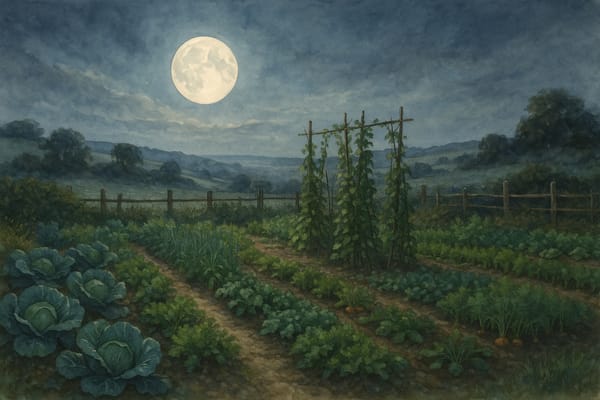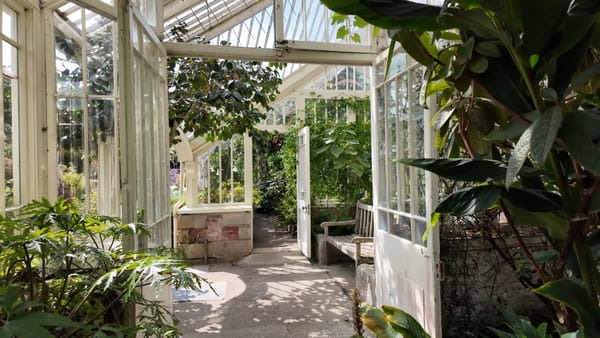As night falls over Cornwall, with its windswept coasts and rolling hills, the moon casts its gentle glow upon the landscape, subtly influencing the land’s rhythm. For centuries, moon gardening has been a practice intertwined with the region’s agricultural traditions, guiding gardeners in their planting, sowing, and harvesting according to the lunar phases. But does this ancient wisdom hold any scientific weight? And can modern gardeners benefit from aligning their practices with the moon?
The Moon’s Subtle Influence on Plants
At its core, moon gardening revolves around aligning gardening activities with the changing phases of the moon. This belief is based on a combination of scientific observations and centuries-old traditions. The idea is that the moon’s gravitational pull, its phases, and even its position in the zodiac, all influence seed germination, plant growth, and even the health of the soil.
Seed Germination: The Full Moon and Waxing Phases
Scientific studies and centuries of tradition suggest that seeds sown during certain lunar phases may show better germination. Seeds sown during the waxing moon, especially those planted two days before the full moon, have shown to germinate more effectively and exhibit stronger growth. This is believed to be due to a combination of increased moonlight and moisture levels in the soil, which help activate enzymes and kickstart seed metabolism.
The moon’s gravitational pull is also thought to raise moisture levels in the soil, making it easier for seeds to absorb water and swell, triggering germination. Some light-sensitive seeds, like lettuce, benefit from the brighter moonlight of the full moon, which can encourage sprouting when sown near the soil's surface.
Sap Flow and Plant Growth
Beyond seed germination, moon gardening has a significant impact on the ongoing development of plants. The waxing moon, which brings increasing light and gravitational pull, is said to promote upward sap flow, supporting vigorous leafy growth. This makes it an ideal time for sowing and transplanting leafy vegetables like lettuce, spinach, and annual flowers.
Conversely, during the waning moon (from full moon to new moon), sap flow is believed to shift downwards, encouraging root growth and nutrient storage. This phase is recommended for planting root crops, such as carrots, potatoes, and beets, where strong, deep roots are crucial for a healthy harvest. The belief is that the decreasing light and gravitational pull during this phase signal plants to focus their energy on establishing strong root systems rather than expanding above ground.
Flowering, Fruiting, and Stress Response
The moon’s effect on plant physiology extends to flowering and fruiting as well. Many plants, especially those adapted to lunar cycles, will synchronize their flowering and fruiting with the moon. Night-blooming flowers, for example, thrive during the full moon when light levels are highest. The gravitational effects of the moon are thought to be particularly significant for flowering plants that respond to the light shifts, while fruiting crops may benefit from the full moon’s influence, leading to richer, juicier yields.
Scientific studies have even shown that exposure to full moonlight can trigger subtle metabolic shifts in plants. For example, laboratory experiments have noted changes in how sugars and amino acids are stored in plants during full moonlight exposure, suggesting that moonlight might boost plant vigor in the long term. However, it's important to note that while these effects are real, they are often subtle and may not outweigh other critical factors such as soil quality, temperature, and water availability.
Incorporating Zodiac Signs into Moon Gardening
While moon phases provide a natural gardening rhythm, seasoned moon gardeners often take it a step further by incorporating zodiac signs into their gardening schedules. The moon passes through each of the twelve zodiac signs roughly every 2–3 days, and each sign is associated with one of the classical four elements: Earth, Water, Air, and Fire. These elements are linked to specific types of plant growth and gardening tasks.
- Earth Signs (Taurus, Virgo, Capricorn) are ideal for planting root crops like carrots and potatoes, as well as transplanting and repotting.
- Water Signs (Cancer, Scorpio, Pisces) are best for leafy greens, such as lettuce and spinach, as well as general planting and watering.
- Air Signs (Gemini, Libra, Aquarius) are favorable for flowering plants and aromatic herbs.
- Fire Signs (Aries, Leo, Sagittarius) are best suited for fruits, seeds, and grafting tasks, but are also great for pruning and general maintenance during barren periods.
By observing both the moon’s phase and its position in the zodiac, gardeners can further refine their planting strategy, choosing not only the right phase but also the right sign to enhance growth.
Scientific Evidence on the Moon’s Gravitational Effects
While gardeners have long believed that the moon’s gravitational pull can influence water movement in the soil, scientific consensus on the strength of these effects is mixed. It’s well established that the moon controls ocean tides, but its gravitational influence on small volumes of water in soil or plants is less clear. Some studies suggest that there may be subtle shifts in soil moisture corresponding to lunar cycles, particularly around the full moon and new moon. However, these effects are likely modest compared to the influence of other factors such as rainfall, temperature, and soil composition.
Despite the lack of robust scientific evidence, many gardeners find that following the lunar cycle adds structure and rhythm to their gardening practices. Observational data from gardeners in Cornwall and elsewhere suggests that aligning planting and maintenance activities with lunar phases yields positive results, particularly for crops like lettuce, potatoes, and other root vegetables.
Adapting Gardening Practices Throughout the Lunar Month
Experienced moon gardeners adapt their tasks to the changing phases of the moon, timing their activities for peak effectiveness. For instance, during the waxing moon, they focus on planting above-ground crops and transplanting seedlings, as the increasing sap flow helps with their growth. Conversely, during the waning moon, they shift focus to root crops and soil maintenance tasks, such as weeding and composting, which benefit from the gravitational pull downward.
- New Moon to First Quarter (Waxing Phase): This is the ideal time to start leafy crops like lettuce and spinach. Gardeners also sow flowers, as increasing moonlight supports their germination.
- First Quarter to Full Moon: Continue planting fruiting crops like tomatoes and beans, and apply nutrient-rich foliar sprays to encourage healthy growth.
- Full Moon to Last Quarter (Waning Phase): Now is the time for root crops—potatoes, carrots, onions—and perennial planting. Prune and weed, and focus on dividing plants.
- Last Quarter to New Moon: This phase is best for maintenance tasks, such as composting, soil preparation, and pest control, as plant energy is at a low ebb.
Many moon gardeners keep detailed records of their planting activities, tracking not just the moon phase but also weather patterns, plant performance, and local conditions. Over time, these records help gardeners fine-tune their approach, aligning their practices more closely with the needs of their individual gardens.
Embracing the Moon’s Rhythm in Cornwall
In Cornwall, with its rich agricultural heritage and deep connection to the land, moon gardening offers a way to harmonize with the natural world. By observing the phases of the moon and its influence on soil moisture, plant growth, and even plant metabolism, gardeners can develop a rhythm to their gardening practices that is both ancient and modern.
Whether you’re growing leafy greens during the waxing moon or harvesting root crops as the moon wanes, incorporating lunar timing into your gardening practices can offer a sense of rhythm and connection to the landscape around you. Even if the effects of the moon are subtle, many gardeners find that paying attention to the lunar cycle adds an extra layer of enjoyment, bringing a deeper sense of meaning to the act of growing plants. So, next time you plant a seed, take a moment to glance at the moon—and perhaps, you’ll discover the secret to even better growth.









